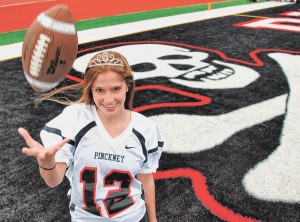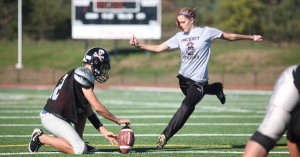Homecoming queen is winning kicker on high school football team
October 12, 2011
 By MICHELINE MAYNARD for The New York Times – Even in a Locker Room Apart, an Undeniable Leap of Progress
By MICHELINE MAYNARD for The New York Times – Even in a Locker Room Apart, an Undeniable Leap of Progress
The most exceptional thing about Brianna Amat, who has become known as the Kicking Queen, is not her twin accomplishments as homecoming queen and place-kicker. It is that she feels accepted as a full member of the high school football team in Pinckney, Mich.
For those of us who were able to play high school sports because of Title IX, and who later dealt with all-male locker rooms as female sports journalists, the fact that Amat can join and play for a boys’ team without harassment or prejudice seems downright remarkable.
She is enjoying an opportunity that thousands of female athletes never were able to enjoy. She is living in a world that female sports journalists don’t even live in now.
Jennifer Gish of The Albany Times-Union was the latest to taste hostility when angry sports fans told her recently to “stay in the kitchen” after she wrote a column critical of the Buffalo Bills.
A generation ago, women could never have imagined being invited to join a men’s team.
Yes, we got to play women’s sports, and we were given the chance to stretch for excellence. But it often came at the cost of our social lives, because you were either a jock or a popular girl, usually not both.
At least that is how I perceived it at my Michigan high school in the 1970s. I’ve loved sports since I can remember, and during my childhood and teenage years, I got to sample just about everything.
I played whiffle ball with the guys on my block, and softball in grade school. We went regularly to Tiger Stadium at a time when women, retirees and children could get in for 50 cents.
My dad introduced me to hockey through the Saturday night telecasts on CBC. He put up a basketball hoop on our garage. We played croquet and practiced putting in the backyard. I learned cricket and took part in touch football on a neighbor’s lawn.
More times than not, I was the only girl. I was teased by the boys, who asked if I wore a cup, and received some pretty disdainful looks from the girls, who spent recess in sixth grade practicing what “Dancing With the Stars” now calls the sexy walk.
Except for playing with my neighbors, I didn’t have many options until Title IX required schools to offer equal opportunities to girls.
A few years after Title IX was enacted, my high school, which already had a girls’ swim team, started a girls’ basketball team, which I didn’t make, and a tennis team, which I did.
But football for girls was never mentioned. That was something we watched from the sideline — as fans, cheerleaders or members of the band or the drum and bugle corps.
 That is why I could barely believe it when Amat told me her women’s soccer coach had suggested to the football coach that she try out for kicker.
That is why I could barely believe it when Amat told me her women’s soccer coach had suggested to the football coach that she try out for kicker.
When I asked if anyone on the team had given her a hard time, expecting that she might evade the question, she said she had never had a problem. She said her teammates treated her as one of the guys.
And her classmates adore her, as evidenced by her election as queen. That is easy to understand, given her easygoing personality and a clear focus that has earned her a 4.0 grade point average and last week landed her on network news shows and almost certainly won her admission to Western Michigan, which she hopes to attend.
But why is it so different for Amat? It may simply be her. But it may also be that times have changed, just enough, so that her strong, accurate kicking foot matters more than her gender.
As an athlete, at least, Amat is no anomaly. In all, 28 girls played on high school football teams in Michigan last season, according to the state athletic association.
Since I wrote my article last week, I’ve heard stories of other girls who held dual titles as football players and homecoming queens, including Heather Cerovski of Kalamazoo, Mich., who played and reigned in 1993.
Their achievements reminded me of my friend Theresa Burgard, the first girl I knew to be awarded an athletic scholarship. A nimble basketball player, she went to Southern Illinois, where she earned a varsity letter each year from 1976 to 1979.
I’ll never forget her grin when I complained of sore legs after a dozen sprints up and down our high school stairs. “It doesn’t stop hurting,” she told me. “You just have to keep doing it.”
Burgard went on to become a beloved women’s track and field coach in Kankakee, Ill., before her death this summer at 54 from lung cancer.
Although I didn’t have a shred of her talent on the court, Burgard was one of the reasons I believed I could be a sportswriter, an assignment I took on in Lansing, Mich., as my first full-time job.
My employer, United Press International, assigned a reporter each season to cover Michigan State football and basketball, and I lobbied for the opportunity.
I ignored the raised eyebrows and skeptical looks I got when I showed up for my first game at Spartan Stadium, armed with only the sketchiest instructions on how to cover football.
Because the reporter would be filing on deadline, U.P.I. also paid a stringer to collect statistics and trek down to the locker room for postgame remarks. Mine showed up at that first game with binoculars. That afternoon, and before every game, he said the same thing: “Time to check out the cheerleaders.”
It made me cringe and I could have called him on it, but I chose not to, because he spared me the dreaded chore of having to go to the locker room. I smile now at my embarrassment, but I wasn’t ready at 21 to see athletes in their towels or underwear.
I couldn’t avoid it, though, when it came time for the annual Michigan-Michigan State game. Rich Shook, then U.P.I.’s Detroit-based sportswriter, claimed the game story, leaving me the gathering chores.
My heart was pounding, and I must have looked petrified because Mick McCabe of The Detroit Free Press came over as we were walking to the locker room on the other side of the field from Michigan’s press box.
“You stick with me,” he said quietly as we stood in the crush of reporters outside the door. Almost on cue, it opened, and I was face to face with the legendary Michigan coach Bo Schembechler.
His surprise was clear and his stare intimidating. Almost immediately, McCabe spoke. “You’re going to let her in, aren’t you, Bo,” he said, a statement, not a question. Schembechler stared at him, barely nodded, and I was finally inside.
That long-ago memory came rushing back last week when Amat told me she has her own locker room, where she dresses separately from the guys. She doesn’t like it because she can’t celebrate with them. But that is the only drawback she sees.
Speaking for my generation of sports-loving girls, and sportswriting women, I hope it’s the only one she ever has to face.
